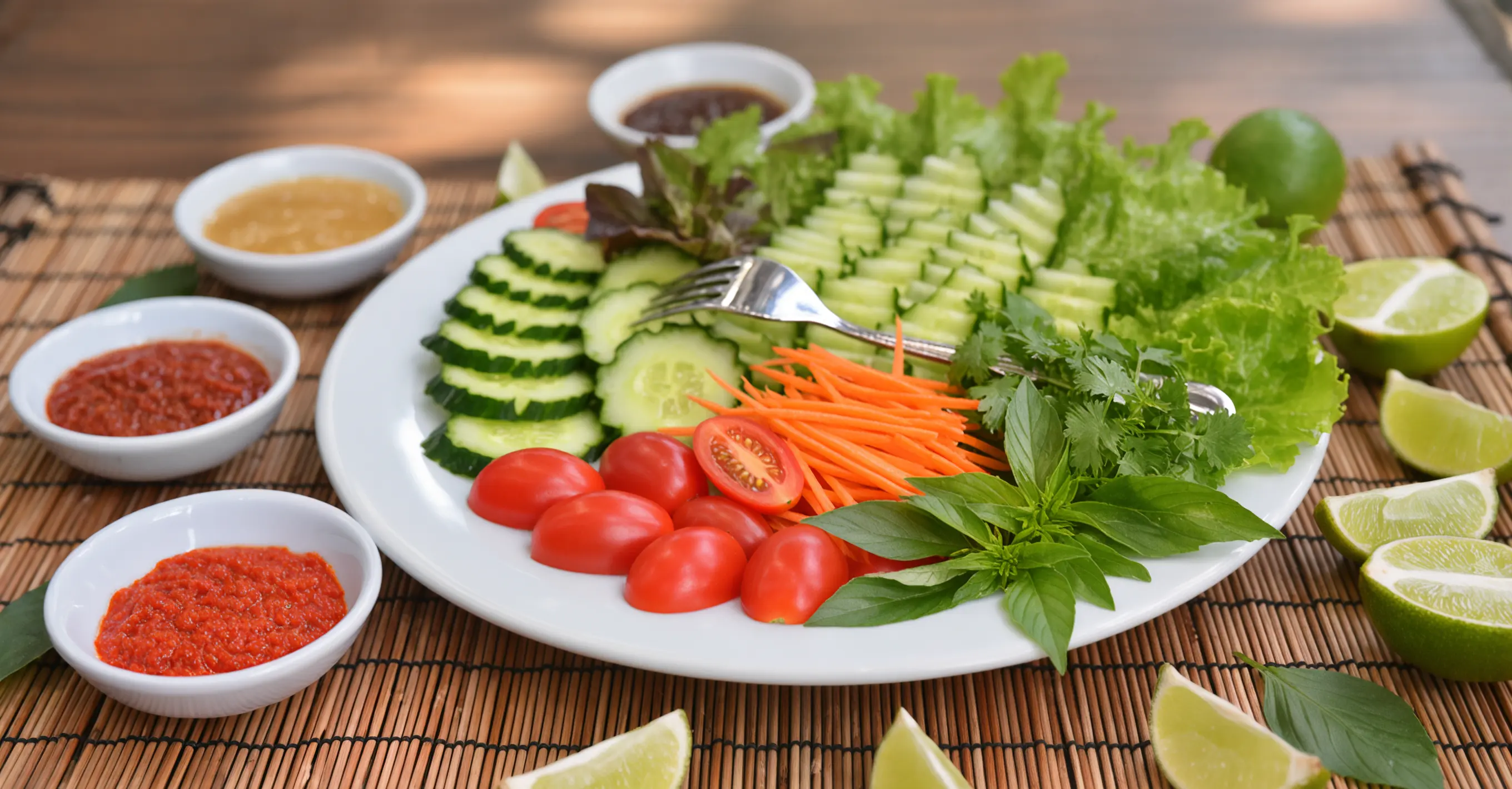
Lalapan (Indonesian Fresh Raw Vegetables)
The ultimate Indonesian side dish that exists for one purpose: to showcase the incredible power of authentic sambal. Fresh, crisp vegetables provide the perfect cooling contrast to fiery sambal heat, creating the essential balance found in every Indonesian meal.
Chef Yossie
Traditional Indonesian Recipe
Interactive Preparation Guide
Master the art of presenting fresh vegetables that showcase sambal perfectly
Wash all vegetables thoroughly under cold running water. This is crucial as the vegetables will be eaten raw.
Equipment needed:
Chef's Tip:
Use a vegetable brush for cucumbers and tomatoes. Consider a vegetable wash if available.
Important:
Extra care with washing is essential - these vegetables are eaten completely raw.
Slice cucumber into 1cm thick rounds. For a traditional touch, score the skin with a fork before slicing for better texture.
Equipment needed:
Chef's Tip:
Scoring the cucumber skin with a fork creates an attractive pattern and helps sambal cling to the surface.
Separate lettuce or cabbage leaves and tear into bite-sized pieces. Remove any tough stems or damaged parts.
Equipment needed:
Chef's Tip:
Tearing by hand rather than cutting with a knife prevents browning and gives a more rustic, traditional appearance.
Halve the cherry tomatoes and julienne the carrot if using. All cuts should be bite-sized for easy eating.
Equipment needed:
Chef's Tip:
Cut tomatoes just before serving to prevent them from releasing too much juice and making other vegetables soggy.
Arrange vegetables attractively on a large serving platter or individual plates. There's no wrong way - make it look appealing.
Equipment needed:
Chef's Tip:
Group similar colors together or create rainbow patterns. The visual appeal is important for this simple dish.
Place sambal in small individual bowls or one central bowl for sharing. Each person should have easy access.
Equipment needed:
Chef's Tip:
Individual bowls prevent double-dipping and allow each person to control their heat level. Provide small spoons for serving.
Garnish with fresh herbs, spring onions, or thin chili slices if desired. Add lime wedges around the plate.
Equipment needed:
Chef's Tip:
Fresh herbs like Thai basil or cilantro add aromatic complexity. Lime is essential - it brightens everything.
Serve immediately while vegetables are crisp and fresh. Provide small spoons for the sambal.
Equipment needed:
Chef's Tip:
Don't let this sit - vegetables will lose their crispness. The contrast of cold, crisp vegetables with room temperature sambal is key.
🛒 Perfect Ingredients for This Recipe
Sambal Oelek - Pure Heat
THE star of Lalapan - fresh, chunky sambal that transforms simple vegetables into an unforgettable experience
Sambal Bali - Aromatic & Spicy
Adds aromatic complexity to the fresh vegetables - perfect for those who want more than just heat
👨🍳 More Delicious Sambal Recipes
Ayam Penyet
Traditional pairing - lalapan is the classic accompaniment to smashed fried chicken
Ikan Bakar
Fresh vegetables provide cooling contrast to spicy grilled fish
📚 Learn More About Indonesian Cuisine
The Philosophy of Indonesian Balance: Hot, Sweet, Sour, Salt
Understand how simple dishes like Lalapan create perfect harmony in Indonesian meals
Sambal: The Soul of Indonesian Cuisine
Discover why every Indonesian meal revolves around sambal and how it transforms simple ingredients
The Essence of Indonesian Dining
Lalapan represents something profound in Indonesian cuisine: the understanding that sometimes the simplest things are the most essential. This isn't just a side dish - it's a philosophy. Fresh, raw vegetables exist to showcase the incredible complexity and heat of authentic sambal, creating a perfect balance that defines Indonesian eating.
Every Indonesian meal, from street food to fine dining, includes some form of fresh vegetables and sambal. The cooling crispness of cucumber, the mild bitterness of fresh lettuce, the sweet acidity of tomatoes - these provide the canvas on which sambal paints its fiery masterpiece. Without lalapan, Indonesian food would be incomplete.
Understanding Indonesian Food Balance
Temperature Contrast
- • Cold, crisp vegetables cool the palate
- • Room temperature sambal provides heat
- • This contrast is essential, not accidental
- • Creates rhythm in the eating experience
Flavor Harmony
- • Mild vegetables don't compete with sambal
- • Fresh textures contrast with cooked foods
- • Clean flavors refresh between spicy bites
- • Natural sweetness balances heat and salt
Regional Indonesian Styles
Sundanese Lalapan (West Java): Often includes kemangi (lemon basil), young cassava leaves, and sometimes blanched long beans alongside the raw vegetables. The aromatic herbs add complexity that pairs beautifully with the region's preference for sambal terasi.
Javanese Style: Tends to be simpler - focusing on cucumber, lettuce, and tomatoes. Often accompanied by fried peanuts and served with the iconic sambal oelek that Central Java is famous for.
Balinese Approach: May include blanched vegetables (jukut urab) alongside raw ones, and often features sambal matah - a fresh, raw sambal made with shallots and lemongrass that's perfect with the crisp vegetables.
Health Benefits of Raw Vegetables with Sambal
Maximum Nutrition: Raw vegetables retain all their vitamins, minerals, and enzymes that cooking can destroy. The vitamin C in tomatoes and cucumbers is particularly high when fresh.
Digestive Benefits: The fresh enzymes in raw vegetables aid digestion, especially important when eating rich, spicy Indonesian dishes. The fiber helps with satiety and digestive health.
Sambal's Health Power: The capsaicin in fresh chilies boosts metabolism, has anti-inflammatory properties, and can help with pain relief. Combined with fresh vegetables, it's a powerful health combination.
Hydration and Cooling: High water content vegetables like cucumber help maintain hydration and provide natural cooling - essential when eating spicy foods in tropical climates.